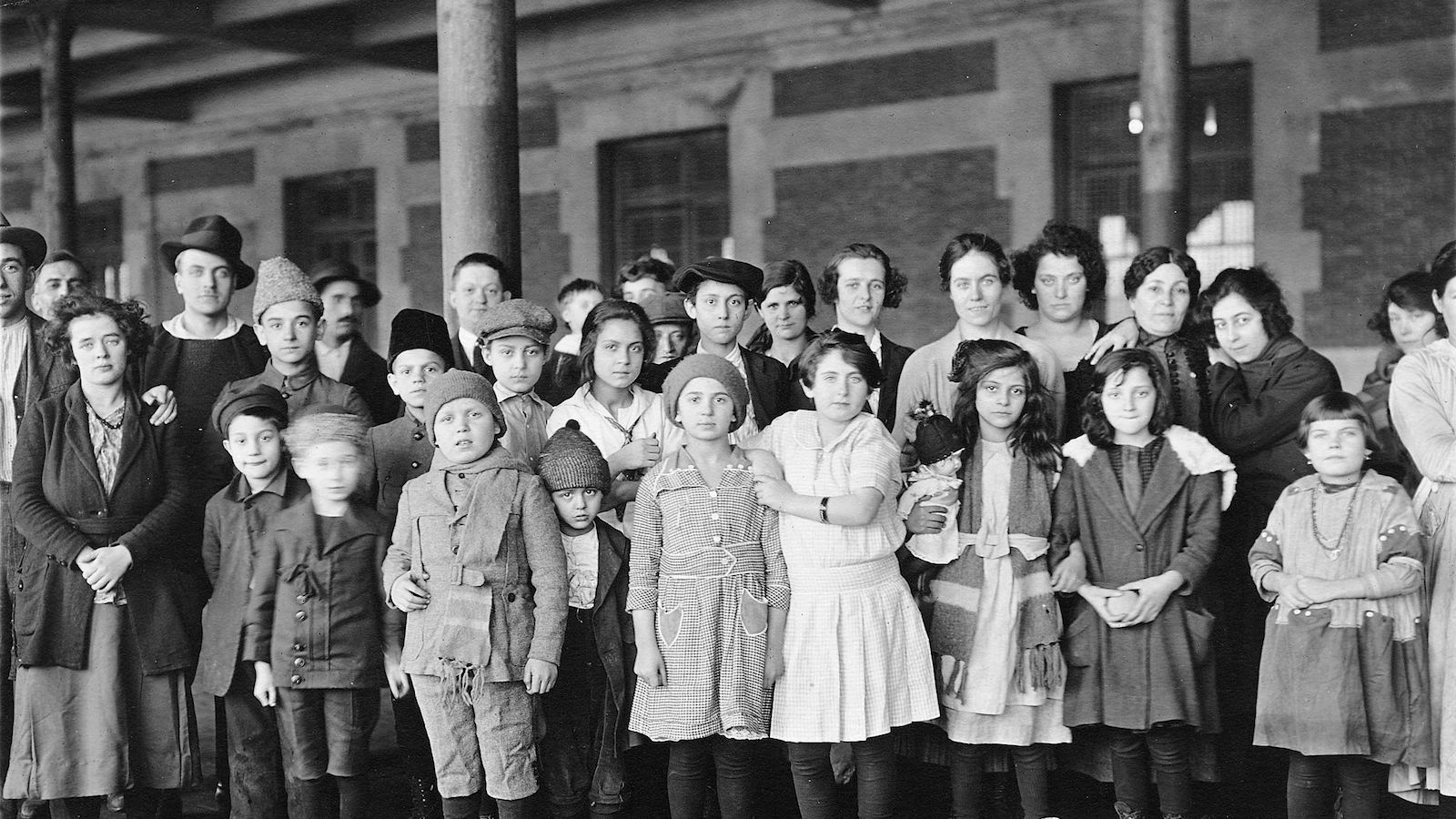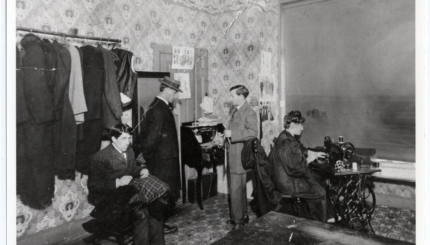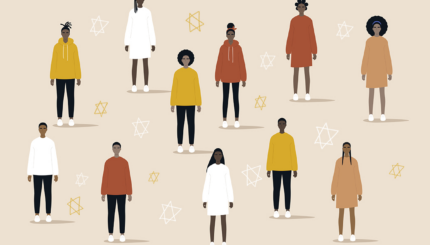As America moved from an agricultural to industrial country in the late 19th century, the forces of modernization transformed the Jewish community as well. While most Jews had originally settled in port cities on the East Coast of the United States, the revolution in transportation created a network of roads, canals, and railroads which influenced Jewish migration westward.
New Frontiers, New Opportunities
A significant number of young Jewish men peddled goods in these new frontier markets, and the more successful ones often put down roots in small towns and cities throughout the South, the Midwest, and the Far West, establishing stores and shops, as well as a nascent Jewish community.
In some cases the early stores evolved into major business enterprises like that of the Shwayder brothers in Denver, Colorado–whose modest trunk company became the internationally known Samsonite Luggage Corporation–and Levi Strauss of blue jeans fame in San Francisco. They also brought Judaism to these regions, organizing religious services for the High Holidays and the Sabbath and forming Jewish burial societies. These activities planted the seeds for future Jewish congregations
The urban centers across the country–New York, Boston, Philadelphia, Baltimore, St. Louis, Chicago, San Francisco, and Los Angeles–were home to the largest Jewish communities by the turn of the 20th century. At the same time, smaller Jewish enclaves dotted the landscape of every state in America. Most of these communities had synagogues that were affiliated with at least one, if not all three, young but dominant Jewish strains of religious affiliation at the time: Reform, Conservative, and Orthodox.
Full Americans & Good Jews
Striving to be viewed as fully American as well as good Jews, Jewish connections were expressed through philanthropy and communal work. Beginning most notably with Rebecca Gratz of Philadelphia in the 1820s, Jewish women took an increasingly prominent role in founding and perpetuating the institutions that grew out of this impulse. Gratz is best remembered as the initiator of America’s first “Hebrew School” and the main impetus behind the Female Hebrew Benevolent Society (1819), which served as the model for future Jewish women’s charitable organizations.

Help us keep Jewish knowledge accessible to millions of people around the world.
Your donation to My Jewish Learning fuels endless journeys of Jewish discovery. With your help, My Jewish Learning can continue to provide nonstop opportunities for learning, connection and growth.
The massive immigration of East European Jews to the United States after 1880 also exerted significant influence on all aspects of life. As historian Jonathan Sarna aptly observes in American Judaism, beginning in the late 19th century, the American Jewish community experienced its own “Great Awakening:” “It was characterized by a return to religion, a heightened sense of Jewish peoplehood, new opportunities and responsibility for women, a renewed community-wide emphasis on education and culture, and a burst of organizational energy.”
Many new Jewish educational undertakings were created during this period, including the creation of the Jewish Publication Society (1888), the Jewish Chautauqua Society (1893), which focused on adult education, and Gratz College, a Hebrew teachers’ college in Philadelphia (1893). Some of these Jewish renewal trends had been germinating for many decades, while others emerged as part of the modernization of America, largely through the influences of urbanization and industrialization.
The Rise of Denominations
By the turn of the century, the key emerging Jewish denominations had also established their own organizations and educational institutions as they vied for adherents. The professed goal of Isaac Mayer Wise, the architect of American Reform Judaism, was to reshape Judaism in a new American context. He played a pivotal role in the founding of the Union of American Hebrew Congregations (1873), Hebrew Union College (1875), and the Central Conference of American Rabbis (1899).
Conservative Judaism adopted a more traditional but modernized and inclusive approach, institutionalized in the creation of the Jewish Theological Seminary in New York City (1887) and the United Synagogue of America. As president of JTS, Solomon Schechter emphasized what he considered Judaism’s dynamic potential for adaptation.
Confronted with the new challenges of a fluid American environment where religious observance appeared to be on the decline, Orthodox rabbis followed differing paths. While a number of Eastern European-trained rabbis insisted on a policy of resistance to modernization, some younger, Western-educated rabbis made what they considered necessary accommodations, including the introduction of sermons in English and greater decorum in the synagogue.
Orthodox Judaism also developed its own leadership structure in America, and in 1898 formed the Orthodox Jewish Congregational Union of America. In 1902, an even more traditionalist segment founded the Agudas ha-Rabbonim, or the United Orthodox Rabbis of America, which lent its support to New York City’s Rabbi Isaac Elchanan Theological Seminary (1897), modeled on the traditional East European yeshiva.
Another important aspect of the Jewish “Renaissance” in America was the creation of the National Council of Jewish Women (NCJW) in 1893, which marked a watershed moment for American women. The NCJW had parallels to similar women’s clubs created by white middle class Protestants, but exhibited a distinctly Jewish dimension with local chapters throughout the country. They emphasized Jewish knowledge, philanthropy, and social welfare reform, and worked to help Americanize new Jewish immigrants.
Also in this time period, affluent, acculturated Jews of German descent– Jacob Schiff, the famous New York City banker among them–helped organize and fund numerous philanthropic and educational programs aimed at poor Eastern European Jewish immigrants. Schiff, the unofficial leader of the American Jewish community at the time, was worried about the threat of rising anti-Semitism and general xenophobia in the United States.
Also concerned with maintaining the positive image of the Jewish community, Schiff sought to demonstrate that Jews took care of their own. Newcomers would become productive members of society, rather than burdens or criminals. As such, his undertakings often included instruction in English language and civics to help ease the transition of the newcomers into American life and turn them into self-sufficient “good citizens.”
Eastern European Immigrants
Between 1881 and 1924, more than 2.5 million East European Jews immigrated to the United States. In New York City, Americanization activities were offered by the Educational Alliance beginning in 1893, but many communities around the United States created similar programs on a more modest scale.
Many established Jewish communities opened local settlement houses (mimicking a popular Protestant model) to provide language classes, lectures on cultural subjects, and lessons in citizenship, as well as hygiene and child-rearing instruction and in some cases even free baths. Jewish social workers such as New York City’s Lillian Wald, associated with the famous Henry Street Settlement, and Minnie Low of Chicago, nicknamed “Jane Adams of the Jews,” earned national reputations as they worked with these newcomers.
The East European immigrants were also active in the shaping of Jewish religion and culture at the turn of the century. New York City became the site of a thriving Yiddish theater and press, and at its heyday in the 1920s, the largest of the Jewish newspapers, Abraham Cahan‘s socialist Forward, boasted more than a half million readers around the country. In its own unique way, the Yiddish newspaper was a vehicle for acculturation, introducing the new immigrants to American mores and presenting lessons in a non-threatening manner.
Eastern European Jews also frequently formed their own charitable and social networks, such as the landsmanschaftn–mutual benefit societies that provided financial and moral support to individuals from their home towns in Europe–and Zionist clubs. As they became more established they created impressive benevolent societies and institutions, as well.
The Labor Movement
The East European immigrants also played a key role in the American labor movement, where they made up a high percentage of garment industry workers. It is estimated that by 1897, 75% of the clothing workers in Manhattan–a leading center of the industry–were Jewish. A number of Russian Jewish socialists transplanted to America attained central leadership positions in the wider American labor movement, including David Dubinsky of the International Ladies Garment Workers Union and Sidney Hillman of the Amalgamated Clothing Workers of America. These activists were influenced by their Russian roots as well as by the horrendous working conditions that characterized most factory sweatshops in New York City.
The tragic Triangle Shirtwaist Factory Fire of 1911 served as one of the most significant catalysts in the Jewish labor movement, and ultimately resulted in American legislation to regulate working conditions. When a fire broke out in the factory, more than 150 people were trapped inside the locked upper floors of the burning building. Most of the victims were young Eastern European Jewish female immigrants.
America at this time provided both unprecedented opportunities and challenges to Jews. As the American Jewish community stepped from the 19th into the 20th century, it began a process of maturation and consolidation, responding to the new challenges of modernity. At the beginning of World War I, nearly 85% of the American Jewish community was of Eastern European origins. These Jews would play a pivotal role in the community’s direction as they increasingly assumed control of key leadership positions.



